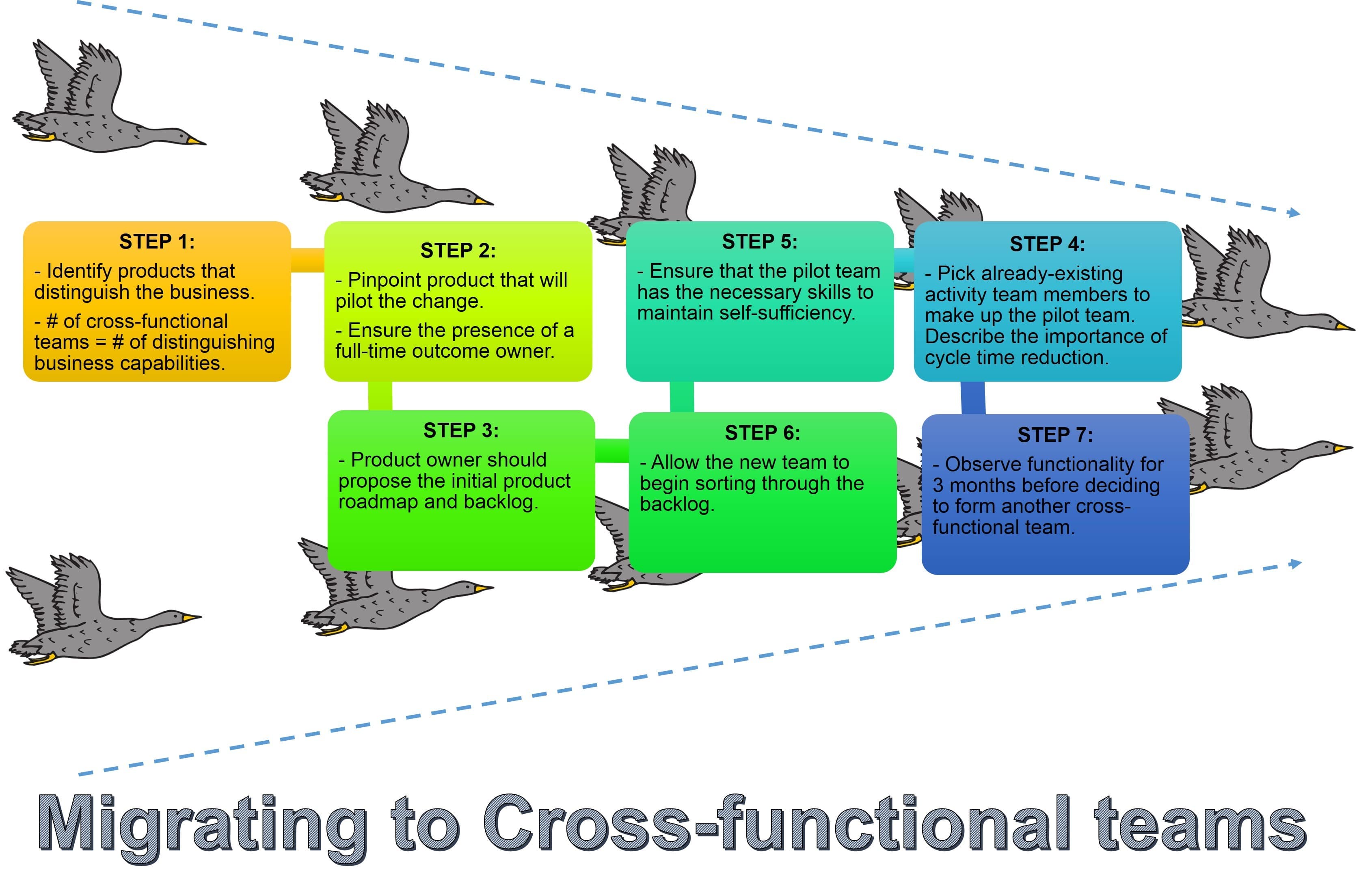
How agile organisational models caters for product management, team management, and functional management is an important decision that dictates how effectively the organisation will function. It dictates the way teams are formed, how these team members interact with one another and other teams, and how well the teams contribute to the overall functionality and success of the organisation.
In this lecture, we will discuss some of these models including the negatively-impacting organisational silos. We will also describe how to migrate from these negative models to a more positive cross-functional model or professor-entrepreneur model. These models promote the formation of cross-functional teams that decrease overall cycle time and cost and are extremely beneficial for organisations and organisational culture.
Organisational Silos
The first organisational model we will explore is that of organisational silos. These are formed by the separation of employees into various groups due to the prioritisation of the group over the employer and product. This becomes problematic and detrimental to the organisation because it does not promote teamwork or organisational flourishing. Rather than increasing teamwork and trust, silos do the exact opposite. Members of the separated groups become less trusting of one another increasing insolence within the organisation. Distrust and insolences leads to secrecy, unwillingness to share information, and a lack of collaboration. As a result, these silos become resistant to change due to the lack of communication, proper leadership and direction, and teamwork. Thus, the organisation cannot change for the better and improve its culture, product management, or success. In the long-term, this detrimentally affects the organisation’s customers as well because the business becomes less able to respond to their concerns and needs.
The below diagram depicts the separation of groups into organisational silos.

To ensure that this separation does not occur and that your organisation does not promote the formation of organisational silos, it is imperative to change models and migrate towards the creation of cross-functional teams.
Cross-functional Teams
A cross-functional/multifunctional/interdisciplinary team is a team comprising members of different specialisations, all of whom work together towards the common goal of the organisation. Unlike organisational silos, the cross-functional model promotes the achievement of the organisation’s outcome/goal involving multiple activities which call for the presence of members from various disciplines and with various skills. Cross-functional teams also ensure that its members own an outcome, contrary to stratified teams created by silos none of which will own the outcome or contribute to the organisation’s success.
Previously discussed Agile and DevOps frameworks exhibit cross-functionality across all areas and cross-functional teams are capable of agility in delivery. This is done by ensuring that the entire software delivery value stream is merged into one team rather than multiple, stratified, activity-oriented teams. This is beneficial for the organisation because it ensures that the cost of handoffs decreases thereby decreasing batch size and, thus, reducing cycle time. All of these factors contribute to an improvement in overall responsiveness of the organisation.
When considering the impact of cross-functional teams on its individual members, it has been seen that these outcome-aligned teams are generally more autonomous than stratified, activity-oriented teams making them more fun to be a part of and, thus, further motivating the members to be productive, efficient, and successful.
The aforementioned advantages of cross-functional teams highlight why it is important for an organisation to ensure migration from negatively-impacting silo models to the cross-functional model. In order to successful achieve this migration several structural, operational, cultural, and political factors must be addressed.
Migrating to Cross-functional Teams
The diagram below depicts the structural aspects needed to accomplish this migration.

Separation of Duties
A concern that comes with cross-functional teams is the separation of duties. Some have suggested that cross-functional teams may not be allowed by certain investor protection regulations e.g. SOX, PCI-DSS etc. Essentially, separation of duties entails the separation of authorisation for making changes to the production environment or its data. The repercussions of this can be avoided, however, by ensuring that members with the necessary combination of authorisations are present on the same team. This allows the cross-functional team to be formed and move forward.
Communities of Practice (CoP)
As mentioned, cross-functional teams encourage and utilise members from multiple specialisations to work together towards a specific outcome. A feature of cross-functional teams that allows this to happen is the encouragement of all specialist members to transform into generalising specialists, without costing the skills in their pure specialty. A community of practice is an association of specialists that are able to communicate and interact for online and offline sharing without having to be part of the same team. A leader is selected to lead sessions, training programs, internal conferences, and member promotions all aimed to enhance the specialist skills of the members. As an organisation, the mastery of its individuals is as much its responsibility as theirs, thus, encouraging members to be part of CoPs or outside activities is beneficial for both the individual and the organisation.
Professor-Entrepreneur Model
To ensure effective communication between all cross-functional teams but still maintain the characteristic autonomy that comes with their formation, a set of Practices and Guilds have been developed. Each Practice is the small group or family of people sharing similar skills and competencies. This Practice will meet periodically to assess challenges and areas of expertise to ensure optimised functionality and communication between members. Each Practice has a leader who is in charge of traditional line management responsibilities, however, this person must also form part of a cross-functional team and must take part in day-to-day work in order to stay grounded.
The below diagram depicts the ongoing communication that must take place between the Practice and cross-functional team.

The Professor-Entrepreneur model takes on the characteristics of a matrix organisational structure, wherein a hierarchy does not exist. Rather than opting for a traditional hierarchical relationship that may promote silos instead of cross-functional teams, this model sets the reporting relationship up in a grid-like formation. This ensures that all employees have dual reporting relationships to the functional manager and product manager. In the case of the professor-entrepreneur model, the product owner/manager (entrepreneur) focuses on quality product delivery whilst the Practice lead (professor) focuses on technical excellence.
This model works efficiently as a result of the professor and entrepreneur’s differing inclinations i.e. the entrepreneur wants to speed things up whilst the professor wants to slow down and build things correctly. This creates a healthy tension between both individuals that allows for a healthy and stable balance. The application of the matrix structure further allows for each team member to receive apt guidance with regards to how to proceed effectively and what requires their attention.
This relationship is shown in the diagram below.

Conclusion
The functional model adopted by an organisation is extremely important in determining the success of the organisation. Avoiding organisational silos and migrating to cross-functional teams promotes an environment in which overall cycle time and cost are reduced whilst teamwork, efficiency, and responsiveness are increased. Practices guilds must be utilised with the leaders of these and the cross-functional teams constantly communicating to ensure that the “what” and “how” of the outcome is being properly managed. Along with this the professor-entrepreneur model is essential in ensuring that all team members are able to find guidance in what tasks must be completed and how they can be completed well. This creates a balance in the organisation wherein constant communication is occurring between all groups, where all team members are working effectively together, and where everyone is working trustingly and openly towards a common outcome. This greatly improves the culture of the organisation and, therefore, its success.
References
In my view one of the more thoughtful works on this topic is: Agile IT Organization Design: For Digital Transformation and Continuous Delivery by Sriram Narayan. It is well worth the read.
A lot of the above reflect the Spotify model, a must read for anyone interested in scaling agile. Scaling Agile @ Spotify with Tribes, Squads, Chapters & Guilds by Henrik Kniberg & Anders Ivarsson. Also an essential read.
Previous Post |
Next post |
How to change organisations |
Self-organising teams |